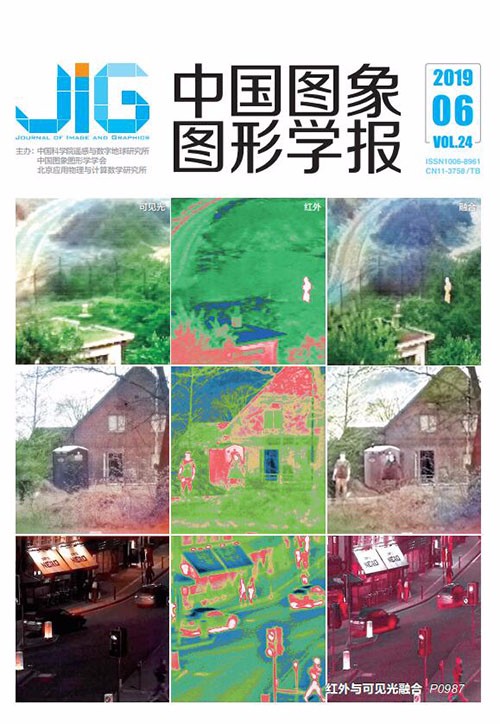
细节感知的纹理滤波算法
摘 要
目的 基于现有的研究提出一种细节感知的纹理去除算法,在去除图像纹理时,能够很好地保持图像的结构信息,尤其是诸如细长结构和边角信息等在其他方法中容易被模糊化的特殊细节。方法 首先,本文提出一种能够识别细长结构的结构检测方法,对细长结构进行检测并增强其结构特征。其次,为了估计每个像素点的最优滤波核尺度,改进原有的相对总变差模型,多方向寻找最小相对总变差,使它能够更好地区分纹理和边界,并且将边角信息从纹理中区分出来。然后,将检测出来的细长结构归一到改进的相对总变差的度量尺度上,估计滤波核尺度,生成引导滤波图像。这样就能够在平坦或有纹理的区域运用大尺度的滤波核,并在结构边缘和边角附近减小滤波核。最后,通过联合双边滤波器得到纹理去除后的图像。结果 实验测试了马赛克图像和艺术画作,对比了相对总变差和尺度敏感的结构保护滤波等方法,本文方法在去除纹理的同时保留了细长结构和边角细节,并且具有良好的普适性和鲁棒性。利用本文算法处理一幅含10万像素的图像,仅通过一次迭代计算就能够去除大量纹理且效果优于已有的方法,本算法的计算时间为3.37 s,其他算法为0.07~3.29 s。结论 本文设计的纹理滤波器不仅在保持诸如细长结构方面的性能更好,而且使纹理去除后的图像在边角细节处更尖锐,为图像的后续处理提供了一种强有力的图像预处理方式。
关键词
Detail-aware texture filtering algorithm
Xiao Yi1, Zhu Xianyi1, He Yangti1, Zheng Yan2(1.College of Computer Science and Electronic Engineering, Hunan University, Changsha 410082, China;2.College of Electrical and Information Engineering, Hunan University, Changsha 410082, China) Abstract
Objective This study proposes a detail-aware texture removal algorithm based on existing studies. When removing image textures, the proposed method maintains the fine structural information of the image, particularly the special details (e.g., slender structure and corner information) that are easily obscured in other methods. With the continuous development of computer technology, the application of image processing technology has become increasingly widespread in pattern recognition, security monitoring, smart driving, computer photography, and other areas. However, the image quality obtained directly from the image acquisition card is not satisfactory. Therefore, image preprocessing is necessary. Texture filtering is an important step in image preprocessing. The image edge in a texture image is the main component of the image structure. Traditional image filter processing techniques, such as median and Gaussian filtering, can filter noise to a certain extent, but the structure context is also filtered. Therefore, this study investigates how to remove texture and maintain the slender structure context simultaneously. Method The main idea of the proposed algorithm is to compute the optimal filter scale by leveraging a novel slender structure recognition technique and an improved structure angle relative total variation based on multiple directions and obtain the filtering result through a guided filter. The method consists of four steps. First, to address the deficiency of existing algorithms, this study proposes a method that can identify and enhance slender structures to avoid smoothing them in the subsequent texture filtering process. Second, to estimate the optimal filtering kernel scale of each pixel, the original relative total variation model is improved by searching the minimum relative total variation in multiple directions so that it can distinguish textures and boundaries effectively, and corner information is effectively distinguished from texture. Then, the detected elongated structure is normalized to the improved metric of relative total variation, and the filtered kernel scale is estimated to generate a guided filtered image. Thus, large-scale filtering kernels are used in flat or textured regions, and the filtering kernels are reduced near the edges and corners of the structure. Finally, a texture-removed image is obtained by combining the joint bilateral filters. Result We evaluate our method on different types of pictures, including mosaics and paintings. Experiments are conducted on a Windows 8.1 operating system, and the proposed method is implemented in MATLAB language. No reasonable quantitative objective evaluation metrics exist in the research field of texture filtering; thus, subjective evaluation by human eyes is commonly used. In the experiments, we compare five existing methods of texture filtering, namely, bilateral texture filtering, rotation guided filtering, relative total variation, scale-sensitive structural protection filtering, and interval gradient operator. Compared with these methods, the proposed algorithm needs a slightly longer computing time. Specifically, for an image with 394×304 pixels, the proposed method consumes 3.37 s, whereas bilateral texture filtering, rotation guided filtering, relative total variation, scale-sensitive structural protection filtering, and interval gradient operator consume 2.23, 0.07, 0.23, 1.01, and 3.29 s, respectively. Our method outperforms these methods in terms of texture removal while maintaining slender structures and corner details. We also analyze the iteration number and parameter value standard deviation (σ) of the proposed algorithm. The comparative experiments demonstrate that with one iteration used to remove texture, the result of our algorithm is better than those of relative total variation and interval gradient operator methods. A large σ is selected when the optimal filter scale is large, and a small σ is equipped when the optimal filter scale is small. Conclusion The texture filter designed in this study performs well in maintaining features, such as elongated structures and sharp corners in an image after texture removal, thus providing a powerful image preprocessing method for image subsequent processing, including image detail enhancement, edge detection, image abstraction, and image segmentation. For the problem of sharp reduction in the filter kernel scale encountered in the experiment, this study provides a reasonable explanation and solution. The proposed algorithm is limited by its long computing time. In general, the proposed algorithm obtains better results compared with others despite its slightly lower computing time efficiency.
Keywords
|



 中国图象图形学报 │ 京ICP备05080539号-4 │ 本系统由
中国图象图形学报 │ 京ICP备05080539号-4 │ 本系统由